The Loch class were anti-submarine warfare frigates built for the Royal Navy and Allies in wartime, an innovative take on the preceding, and very similar River class Frigates, but incorporating three years of experience in the Battle of the Atlantic. However like the River class, mostly civilian shipyards were contracted, but the more advanced design led to some building issues and delays, so in the meantime, the smaller and simpler Castle-class corvette, and evolution of the famous Flower, were introduced. Eventually only 28 ships on the 82 planned (54 cancelled) were completed from April 1944. When operational, the Battle of the Atlantic was nearly over and they had a short career in the RN, many being resold postwar to the RNZN, SAFN, and Malaysian Navy aside their use by Canada. The last were discarded in 1978.
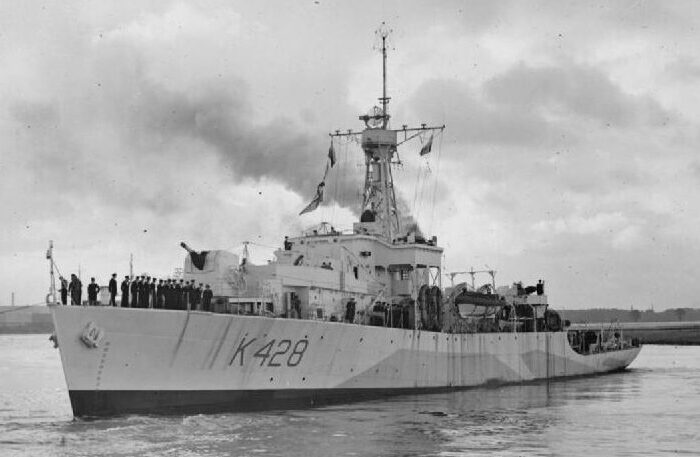
Development
The River class frigates, planned already by late 1940 as the new ASW corvettes of the Flower class, derived from a whaler and built by Civilian yards, would not be enough, both too slow and too weakly armed for the job. The admiralty wanted a proper, large, seaworthy, fast and well armed escort with proper military value. They were designed with a larger hull two engines instead of one, better speed, twice the range at 12 knots (average convoy speed) and early war lessons applied to the Armament, doubled, with a twin 4 in (102 mm) forward gun, a 12-pounder (76 mm (3 in)) aft with enough depression to fire at close range on surfaced U-boats, extra AA, Bofors and Vickers 0.5 inches, two depth charge rails aft, four side-mounted throwers and up to 8 for some and later, an Hedgehog anti-submarine mortar forward which became standard. However by 1943, after 151 ships being built, almost half by Canadian Yards, showed the limitations of the design and improvements that could be made.
The admiralty thus looked for a improved “River” with much superior anti-submarine armament, and with hulls designed for prefabrication to speed up construction, albeit it was still to be performed partly by civilian yards, the same already cranking up Flower and River class ships. This was not an easy decision,
Plans were ready and approved in the summer of 1942. A prototype was converted on the stocks: HMS Loch Achanalt (K424) ordered on 24 July 1242 to Henry Robb Limited, at Leith initially as the River class HMS Naver, laid down on 14 September, but later changed to a Loch class, launched first in class on 23 September 1943 and completed on 11 August 1944, then sent to the RCN.
The other three ships ordered in the 1942 program were ordered in January 1943 and laid down in June, September and October 1943, completed in April, June and November 1944 for an approximate construction time of 12-13 months which was not that impressive for their prefabricated hulls as planned. The concept was slow to initiate and really operational in 1944, this also caused issues to the civilian yards, not accustomed to work with these new assembly techniques. Many logistic issues had to be treated as well. It was also understood that the armament would be much reinforced given recent ASW experience.
The ships were all laid down in 1943-44 and completed in 1944-46, Loch Fada being the “official” lead ship, as she was properly laid down as a Loch class. Fitting out was concentrated at Hendon Dock and Daimuir Basin on the Wear and Clyde. 26 were converted to later ‘Bay’ class frigates with a heavier AA armament while under construction, and 54 were cancelled: Lochs Affric, Clunie, Ericht (Ailsa), Awe, Enock, Eye, Eynort, Gol, Hourn, Inchard, Kirkaig, Laro, Lurgain, Ronald, Sheallag, Shiel, Stemster, Striven, Sunart, Swin, Tummel, Vanavie (Harland & Wolff}, Badcall, Caroy, Knockie, Linnhe, Ryan, Scridain, Tilt (Pickersgill), Creran, Doine, Glashan, Harray, Ken, Linfern, Minnick, Ossian, Skaig, Stenness (Smiths Dock), Earn, Skerrow (Hill), Ensort (Barclay Curle), Garve, Maberry (Hall Russell), Griam, Kirbister, Lyon (Swan Hunter), Kishorn, Nell, Odairn (Robb), Tanna, Urigill, Vennachar, Watten (Blyth). Most if not all of these would have had a 4in Mk XXI gun. Up to 10-20mm were carried, but only 4 in those later fitted with 2 Bofors (Loch Craggie, Loch Eck, Loch Glendhu) and none in those with 6 Bofors (Good Hope, Transvaal, Natal).
Design of the Loch class
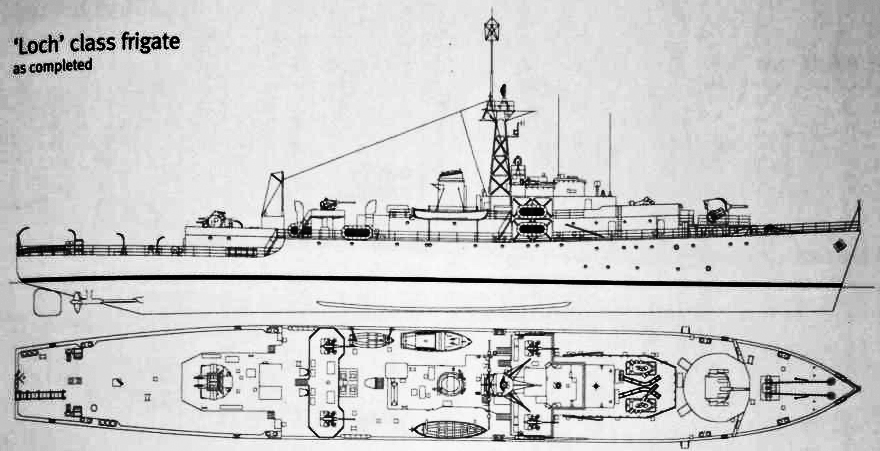
2 views of the Loch class as reconstructed from plans (casemate books). Unfortunately there are no available plans of the Loch class in open source.
The Lochs were based upon the hull of the preceding River class, but with increased sheer and flare in order to improve seakeeping and it was still modified to suit its mass pre-fabrication, transitioning to a longitudinal hull framing system with a wide use of welding. The sections were to be made in another part of each yard, with the sections assembled from elements coming from other manufacturing sites, and welded together at the shipyard. Each section in size and weight could be carried by rail on a standard flatcar if needed. Albeit in general proportions and accomodations this was a copy-paste of the Rivers, the design had been simplified with elimination of as many curves as possible. This led to a noticeable kink in the main deck as the increased sheer started forwards, meeting the level abreast the bridge. Adaptability to production was paramount in all revisions of the design.
Otherwise, the general design was about the same, with a long forecastle about 2/3 of the lenght, transom stern, long structure forward ending with a space decicated to the 3-barrelm squid mortar and reloads, then on deck’s bandstand, was located the main twin gun turret. The single track and launchers were located on the lower aft deck and its structure supported the quad “pompom” AA mount. 20 mm AA guns were located on the bridge’s wings, and on a transverse platform aft of the funnel. The biggest giveway compared to the River class was their lattice mast, instead of the previous tripod. This was to mount, larger, heavier radar with room for future additions. Each ship had two service boats under davits aft of the bridge, and six large rafts located along the structure.
Powerplant of the Loch class
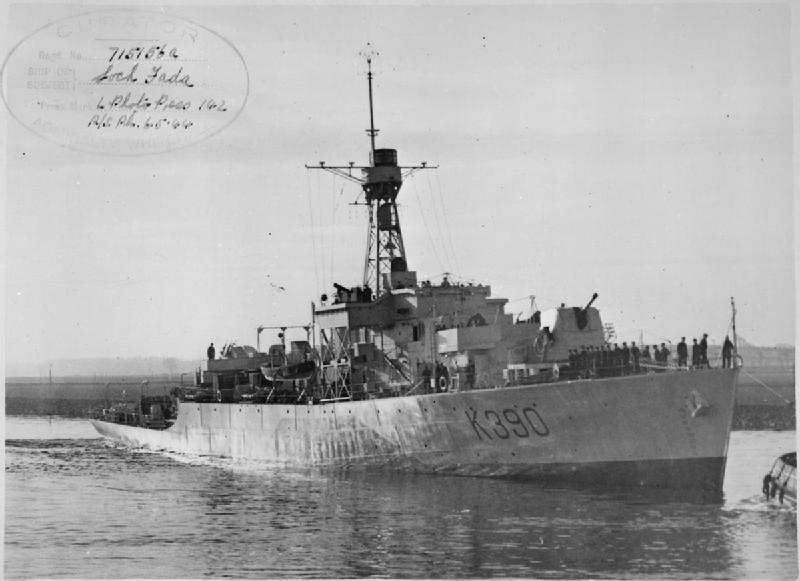
Loch Fada underway in 1944.
Since they were built in civilian yards mostly, like the River class they had to be equipped with mercantile machinery to speed up construction. The majority had a sturdy pair of 4-cylinder vertical triple-expansion reciprocating engines. That mercantile machinery came with the added benefit of being instantly familiar to reservist and volunteer former merchant marine crews manning them. So the arrangement was a repeat of the River class, 2 shafts driven by two vertical triple-expansion steam engines fed in turn by Admiralty 3-drum boilers.
Top speed was between 19.5 and 20 knots (37 km/h; 23 mph) depending on the sources, more than enough to keep pace and catch up with any convoy after a sub chase. Range was 9,500 nmi (17,600 km; 10,900 mi) at 12 knots (22 km/h; 14 mph), better than the River class, 7,200 nmi (13,300 km; 8,300 mi) at 12 knots (22 km/h; 14 mph) based on 440 long tons (447 t) oil fuel. The Loch class carried 724t of fuel.
To compare the River class also were nearly all completed with the two Admiralty 3-drum boilers feeding two reciprocating vertical triple expansion engines for a total output of 5,500 ihp (4,100 kW).
However Loch Arkaig and Loch Tralaig were the exception, completed with spare Parsons single reduction steam turbines rated for 6000 hp (versus 5500 on the VTE), testing such installation. However there were shortage of such sets for all vessels. These vessels by analogy with the River class were probably capable of 20-20.5 knots (38.0 km/h; 23.6 mph).
Armament of the Loch class
The Loch class was designed around the new new Squid, as an ahead-throwing A/S mortar far more competent than the initial “blind firing” Hedgehog, a spigot mortar. Depth charges were still part of the package, and were located on the aft deck. Unlike late River class which for some tested as much as eight Y-Guns (grenade throwers) the standard provision was just two. To go with ther more competente Squid, these ships had a brand new ahead-looking ASDIC (sonar).
Squid ASWRL
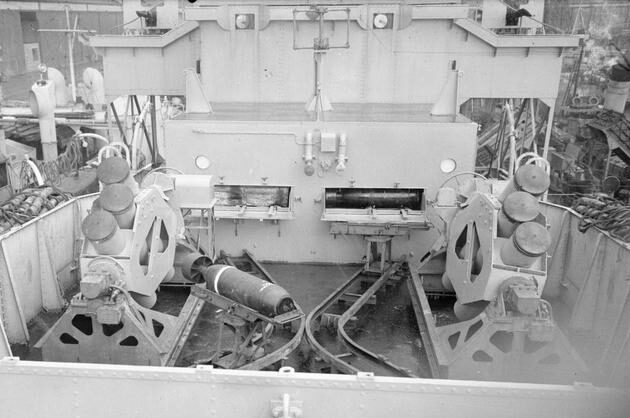
The squad lobbed three 12 in (300 mm), 390 lb (180 kg) warheads up to 600 yd (550 m) ahead in a triangular pattern of high explosives around the presumed location at just 40 yd (37 m) apart. The combined detonation waves was believed enough to rupture the sub’s pressure hull, according data was accurate, with the extra chance of a direct hit.
It’s the clockwork fuses that detonated the warheads at a depth data fed automatically by the ASDIC set befpre launching, when full ASDIC contact was acquired. The Loch class carried two sets of three mortars on turntable mounts to cover at least 180° ahead angles. The bombs, much more powerful than standard Depth charges, worked on a convergent pressure wave to crush the pressure hull and this new weapon, inaugurated by this class, also had a first successful “kill” by the aptly named Loch Killin on 31 July 1944, claiming U-333. The Squid’s reload was also semi automatic and it was such a deadly instrument that the traditional DC provision after was reduced in time just to 15, single rack and a pair of throwers. As a result the Loch had a much “cleaner” aft deck compared to the River class, also safer due to the lower concentration of high explosives. The Squid was the main ASW weapon for British Frigates in the cold war as well until replaced by the Limbo system.
QF 4-in/40 Mk.XIX
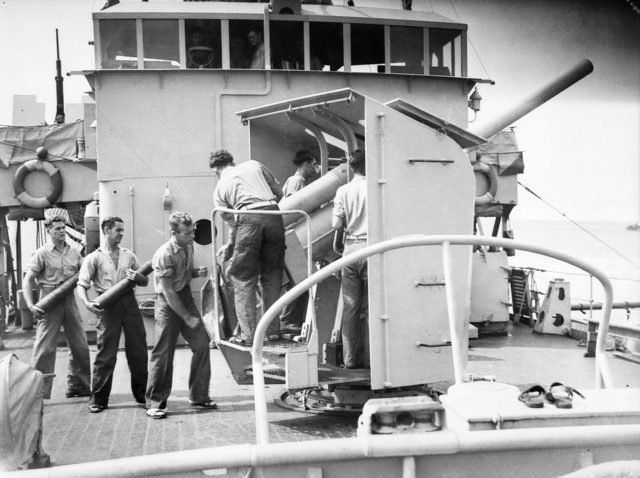
The crew was partialy protected by a 3-sides shield. This low-velocity model came from the Bathurst class and was aldo adopted on the Castle class corvettes. It was intended to deal with surfaced U-Boats and was believed enough for the task. With twice the armament of a Flower class at least it was consitent with the new night surface tactics of the Wolfpacks in 1943.
-Barrel length: 160 inches (4.064 m) bore (40 calibres)
-Shell: Fixed QF HE, Starshell
-Shell weight: 35 pounds (16 kg)
-Calibre: 4-inch (101.6 mm)
-Breech: horizontal sliding-block
-Elevation: -10° to +60°
-Muzzle velocity: 396 metres per second (1,300 ft/s)
-Maximum firing range: 8,870 metres (9,700 yd) at +40°
“Shark” anti-submarine projectiles:
These shells were developed for use in 4-in. guns for surfaced U-Boats. The secret program name was “Shark”, official ordnance was “projectile, 4-in., anti-submarine.” It was designed to hit the water just short of the U-Boat, strike the hull underwater when the water tamping wouls make the detonation more effective. Development started when it realized S.A.P. shell were likely to glance off the pressure hull.
On the narrow conning-tower, they would often go clean through before bursting, and would not prevent the boat diving. H.E. shell had too weak fragments to g through both the outer and pressure hull. The latter was just too thick. Larger calibers were better, provided that had enough depression.
The “Shark” was however heavy and unwieldy buy worked as an A.P.meaning it was supposed to pierce the pressure gull before bursting and was immune from ricochet due to its shape, at all angles even at less than 15 ft. above the waterline and its fuze had sufficient delay to permit penetration, allowing the 25 lbs. Torpex to cause a large hole in the pressure hull.
Indeed when hitting the water the “Shark” continued to move on substantially along the same trajectory albeit loosing velocity rapidly (from 500 ft/s) and so was more efficient at short range allowing a more steeply trajectory. If too downwards velocity will die with the added water encountered or it would miss the U-Boat untirely. Since it was a heavy and unwieldy round, the rate of fire was also much slower. It was customary to have the guns pre-loaded with these and a crew well trained to pickup more read-rounds for an average of three rounds a minute. The gun layers also learned in heavy weather to wait to the end of the roll and get sufficient depression. Dials were modified with a special “Shark” scale.
Crews were trained on 19 ft. long targets divided by a longitudinal bulkhead and by two transverse bulkheads into six compartments and the goal was to leanr to land one in each compartment, if done well there would be enough flooding to sink the target.
First tests were performed by H.M.S. Kingfisher, moored at 100 yards range on a mock U-Boat and were successful. At the time a single projectile caused enough damage it was judged much in excess of what was necessary and avoided further firing. Later tests were performed on captured U-Boats notably postwar. The shell was then ready to be used in the cold war, albeit with the Type XXI tech being copied by the Soviets, the ammunition soon became obsolete.
One of the criticism was its different propellant charge, making logistics more difficult. However by lack of anticipation only a small number of these projectiles were available for Western Approaches by the end of March 1944. More were allocated in May. More variants of the shell were designed for 3-inches, 12-pdr., 4.5-inches. and 4.7-inches guns also used by the RN but it did not concluded in most cases as the war ended.
QF 20mm Oerlikon AA
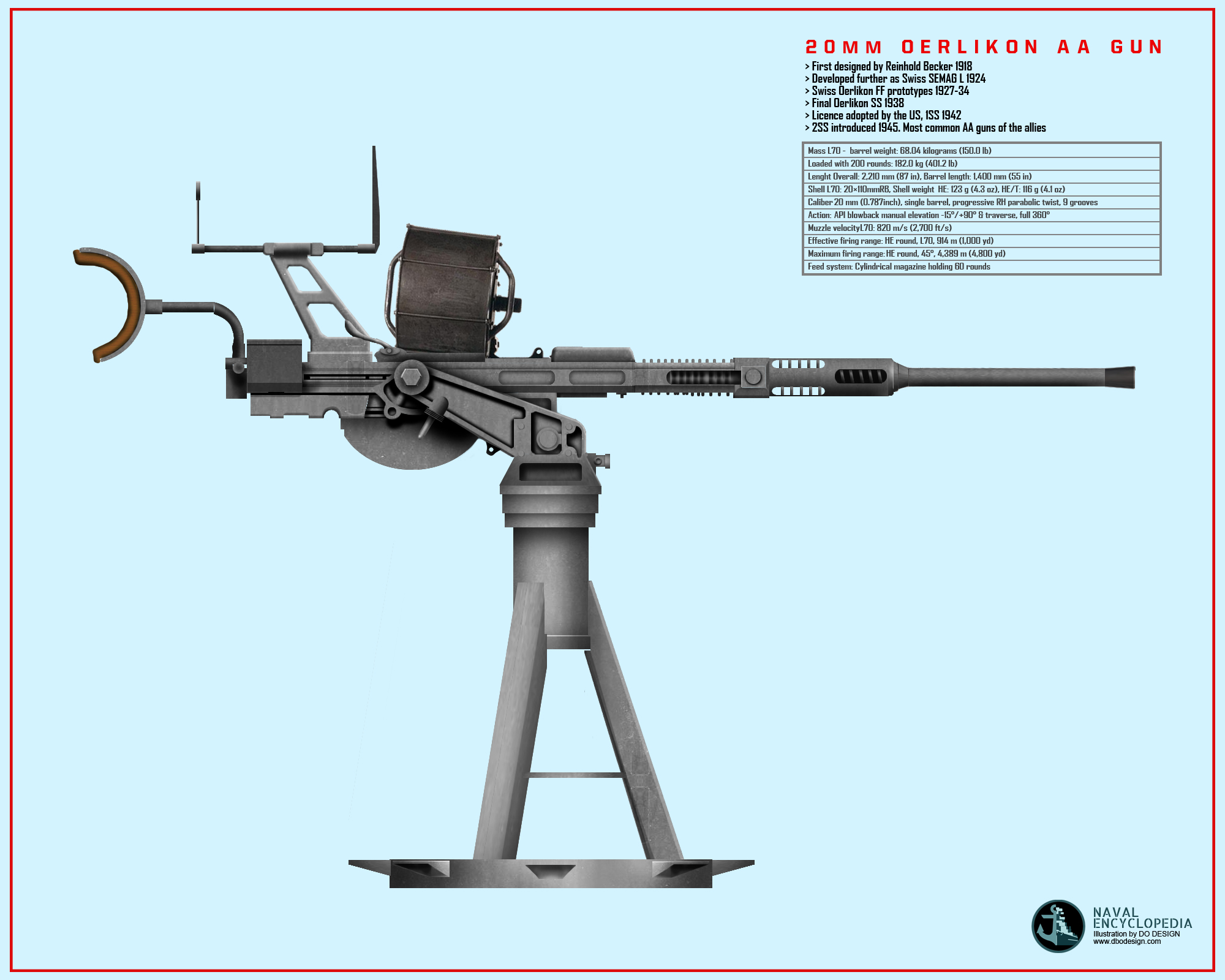
Cheaper, smaller (and thus easier to install) and more common, the US-pattern 20mm/70 Oerlikon Mk.III (single) was adopted, as well as the Mark.V twin mounts, at the same places of the former Bofors. Typically in 1944, all ships carried six ingle 20mm/70 plus six twin 20/70 Oerlikon Mk II/IV, or four twin 20mm/70 Oerlikon Mk II/IV and two single 20mm/70 Oerlikon Mk II/IV.
QF 40mm Bofors AA
40mm/60 Mk 5 were introduced in single and twin mount on modernized ships in the 1950s in replacement to the Oerlikon guns. HMS Inver received two twin 40mm/56 Bofors Mk VIII/IX/XI and two single 40/56 Bofors Mk I/III in 1944 in addition to its Oerlikon 20mm guns, and in 1945, HMS Meon and Usk had three twin 20mm/70 AA and three single 40mm/56 Bofors Mk I/III. Some were mounted in 1945 on Australian River class frigates as well.
Depth Charges
The throwers launched a DC at about 60 m on either side. The flower class had four Mark II DCTs, aft on the poop deck. The river class being longer, it was doubled to eight. This allowed a substantial “broadside” to be thrown if a target was detected on either side.
This was completed by two Depth Charge Racks (DCR) at the stern. The single railings hold five DCs each. There were extra railing to the aft superstructure to roll extra ones. Where again the Flower class had 40 more DCs in store, the River class had 90, so more than double, and it reached 140 on late production vessels.
-Hand reload with winches
-Mark VII type (1939)
-420 lbs. (191 kg) overall
-290 lbs. (132 kg) TNT warhead
-Sink Rate/Terminal Velocity 9.9 fps (3.0 mps)
-Max depht setting 500 feet (182 m) from 1943.
From late 1944, the Mark X and Mark X* were introduced. The X** arrived too late but was capable of reaching 1,500 feet (457 m).
The weapons outfit was completed with a QF 4 in (100 mm) Mark V gun forwards. An oversight in the River design had been to place the gun in the favourable position forward on the shelter deck, with the ahead throwing Hedgehog on the main deck, exposed to the worst of the seas breaking over the fo’c’sle, consequently this was reversed in the Lochs; the Squids being on the shelter deck behind protective bulwarks. For anti-aircraft (A/A) defence, a quadruple mounting Mark VII QF 2-pounder was shipped aft along with up to twelve 20 mm Oerlikon guns, in two twin powered mounts Mark V in the bridge wings and eight single pedestal mounts Mark III. Loch Arkaig, Loch Craggie, Loch Eck, Loch Glendhu, Loch Tralaig and the South African Navy ships HMSAS Good Hope, Natal and Transvaal carried single Bofors 40 mm L/60 gun mounts in lieu of the twin Oerlikons.
Sensors
Type 277 Radar:
The Lochs carried the Radar Type 277. This set used the cavity magnetron to transmit on centimetric wavelengths for target indication, excelling at picking out small targets such as a submarine periscope or snorkel from the surface clutter. The increased weight of the stabilised antenna array and the carriage of HF/DF at the masthead meant that a lattice mast was stepped in lieu of the traditional tripod or pole.
Type 271 Radar:
Some vessels completed with Radar Type 271 or 272 and the associated “lantern” radome until Type 277 became available.
Type 144/147B ASDIC:
ASDIC Type 144 was carried for search and attack while the Type 147B was used for depth finding.
Modernizations
In 1945, earlier ships generally received two twin 20mm/70 Oerlikon Mk II/IV on their aft tranverse bandstand. 1945, Loch Craggie, Loch Eck, Loch Glendhu saw the removal of their Oerlikon A guns for two single 40mm/56 Bofors Mk III and two 20mm/70 Oerlikon Mk IV on a new mount.
Postwar, Loch Achanalt, Loch Achray, Loch Alvie, Loch Arkaig, Loch Dunvegan, Loch Fada, Loch Fyne, Loch Gorm, Loch Insh, Loch Katrine, Loch Killin, Loch Killisport, Loch Lomond, Loch More, Loch Morlich, Loch Quoich, Loch Ruthven, Loch Scavaig, Loch Shin, Loch Tarbert, Loch Tralaig kept their quad pompom but had four Bofors Mk VII, four twin 20mm/70 Mk V, two single 20/70 Mk III, Squid, DCT, DCR and an unchanged radar suite. Loch Craggie, Loch Eck, Loch Glendhu also kept their pompom but had only two single 40mm/60 Bofors Mk III, and four single 20mm/70 Mk III.
Depot Ships conversions
Loch Assynt and Loch Torridon were modified whilst under construction as depot ships for coastal forces. They were rearmed with a twin QF 4-inch (100 mm) Mark XVI on a Mark XIX mount forward at first and six single 20 mm Oerlikons. However they were converted postwar as full depot ships for minesweepers and small MTBs, with a rebuilt structure and accomodations, and a full displacement which went to 2,160t, armament eventually reduced to two 40mm/56 Bofors guns.
Bay Class conversion:
A forecast for additional fleet A/A escorts was increased for the Far East and twenty-six Loch class were redesigned and renamed as Bay-class anti-aircraft frigates to join the British Pacific Fleet.
Cold war modernization::
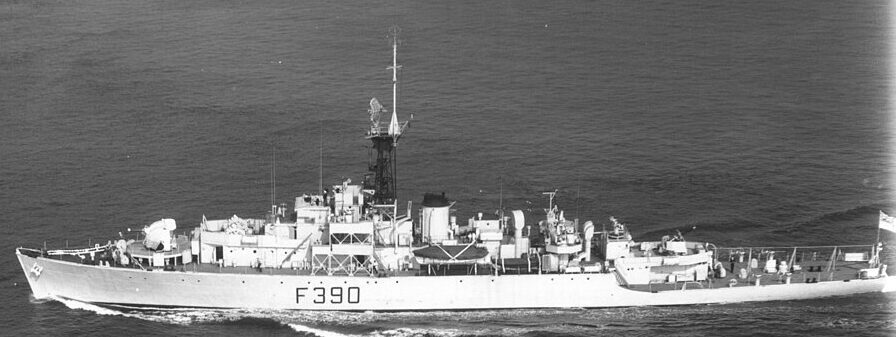
Loch Fada after her 1953 modernization
In 1953, seven Loch class frigates were modernised: Loch Alvie, Loch Fada, Loch Fyne, Loch Insh, Loch Killisport, Loch Lomond and Loch Ruthven.
-4-inch (100 mm) replaced by twin 4-in mounting HA/LA Mark XIX
-AA just twin Bofors Mark V, four single Mark VII, guided by Tachymetric Director.
Their Radar Type 277 was also modernized, fitted with a new ANU antenna array.
Loch Killisport also tested on its main guns a GRP gunshield. The new composite was mostly intended to deal with adverse weather rather than shrapnel, but it enable to test the future housing of the new 4.5-inch gun Mark 8. Loch Fada was paid off in 1967, testing the first British VLS (vertical launch system) for the new Sea Wolf missile.

⚙ specifications |
|
| Displacement | 1,435 long tons (1,458 t) |
| Dimensions | 307 ft 9 in x 38 ft 9 in x 8 ft 9 in (93.8 x 11.8 x 2.7 m) |
| Propulsion | 2 shafts VTE: 5,500 ihp (4,100 kW), 2 Admiralty 3-drum boilers |
| Propulsion* | 2 shafts Parsons steam turbines: 6,500 shp (4,800 kW), 2 Admiralty 3-drum boilers |
| Speed | 20 knots (37 km/h; 23 mph) |
| Range | 9,500 nmi (17,600 km; 10,900 mi) at 12 knots (22 km/h; 14 mph) |
| Armament | 1x QF 4-inch Mark V, 1×4 QF 2-pdr pompom, 2×2+2-8×1 Oerlikon 20mm AA 2× Squid AWSRL, DCR, 2 DCTs |
| Sensors | Types 144 and 147B ASDIC, Type 277 surface-search radar |
| Crew | 114 |
Construction and transfers
One hundred and ten vessels ordered, twenty-eight were built as frigates, entering service from 1944. Another two – Loch Assynt and Loch Torridon – were converted while building and completed as Coastal Forces Depot Ships, being renamed HMS Derby Haven and HMS Woodbridge Haven. Due to a need in 1944 for a version fitted as anti-aircraft vessels with the British Pacific Fleet, twenty-six units were authorised for completion to a modified design labelled the Bay-class frigate and were renamed. A further fifty-four Loch-class vessels were cancelled in 1945.
Of the twenty-eight Loch-class frigates completed as such, Loch Achanalt, Loch Alvie and Loch Morlich were transferred to Canada in 1943 but retained their Royal Navy names and were returned after the war; a fourth ship – Loch Fionn – was also earmarked for transfer but was retained by the Royal Navy as a Bay-class frigate. Loch Ard, Loch Boisdale and Loch Cree were transferred to South Africa as Transvaal, Good Hope and Natal respectively on completion. In 1948, six vessels, including two of the ex-Royal Canadian Navy trio, were refitted from reserve and transferred to New Zealand. During the Korean War, the Royal Navy reactivated several vessels and transferred them to the Mediterranean where they released Ch-class destroyers for war duties. In 1964 Loch Insh was transferred to Malaysia.
 Royal Canadian Navy
Royal Canadian Navy
-HMCS Loch Achanalt (K424)
-HMCS Loch Alvie (K428)
-HMCS Loch Morlich (K517)
All three were returned to the Royal Navy in 1945.
-HMSAS Good Hope (K 432) (ex- HMS Loch Boisdale). Scuttled as an artificial reef in False Bay, 12 December 1978.
-HMSAS Natal (K 10) (ex- HMS Loch Cree). Survey ship 1957. Sunk as a target off the Cape, 19 September 1972.
-HMSAS Transvaal (K 602) (ex- HMS Loch Ard). Scuttled as an artificial reef in False Bay, 3 August 1978.
In the SAFN, modernizations gave interesting conversions. In 1955, Good Hope (prototype) and in 1962 Transvaal were converted as dispatch/training ships with the removal of their 4-in/45 gun replacement by a twin Mk 19 and a flight deck for helicopter.
 Royal New Zealand Navy
Royal New Zealand Navy
HMNZS Pukaki (ex- HMS Loch Achanalt). Broken up in January 1966 at Hong Kong.
HMNZS Kaniere (ex- HMS Loch Achray). Sold in 1966 for breaking up at Hong Kong.
HMNZS Rotoiti (ex- HMS Loch Katrine). Sold in November 1966 for breaking up at Hong Kong.
HMNZS Hawea (ex- HMS Loch Eck). Sold in September 1965 for breaking up in Hong Kong.
HMNZS Taupo (ex- HMS Loch Shin). Sold 15 December 1961 for breaking up.
HMNZS Tutira (ex- HMS Loch Morlich). Sold 15 December 1961 for breaking up.
Ex-Royal Navy vessels, transferred from 1948.
Hang Tuah was the ex- HMS Loch Insh, retired and scrapped in 1977.
 Cancelled 54 ships
Cancelled 54 ships
HMS Loch Affric (K 601) from Ailsa Shipbuilding, Troon.
HMS Loch Clunie (K 607) from Ailsa Shipbuilding, Troon.
HMS Loch Ericht (K 612) from Ailsa Shipbuilding, Troon.
HMS Loch Erisort (K 613) from Barclay Curle, Glasgow.
HMS Loch Garve (K 617) from Hall Russell.
HMS Loch Griam (K 621) from Swan Hunter.
HMS Loch Harray (K 623) from Smith’s Dock.
HMS Loch Ken (K 626) from Smith’s Dock.
HMS Loch Kirbister (K 629) from Swan Hunter.
HMS Loch Linfern (K 631) from Smith’s Dock.
HMS Loch Linnhe (K 632) from William Pickersgill.
HMS Loch Lyon (K 635) from Swan Hunter.
HMS Loch Minnick (K 637) from Smith’s Dock.
HMS Loch Nell (K 641) from Henry Robb.
HMS Loch Odairn (K 642) from Henry Robb.
HMS Loch Ossian (K 643) from Smith’s Dock.
HMS Loch Ryan (K 646) from William Pickersgill.
HMS Loch Scrivain (K 649) from William Pickersgill.
HMS Loch Tanna (K 652) from Blyth Dry Dock.
HMS Loch Tilt (K 653) from William Pickersgill.
HMS Loch Urgill (K 656) from Blyth Dry Dock.
HMS Loch Vennacher (K 657) from Blyth Dry Dock.
HMS Loch Watten (K 659) from Blyth Dry Dock.
HMS Loch Awe from Harland & Wolff.
HMS Loch Badcall from William Pickersgill.
HMS Loch Caroy from William Pickersgill.
HMS Loch Doine from Smith’s Dock.
HMS Loch Creran from Smith’s Dock.
HMS Loch Earn from Charles Hill & Sons.
HMS Loch Enoch from Harland & Wolff.
HMS Loch Eye from Harland & Wolff.
HMS Loch Eyenort from Harland & Wolff.
HMS Loch Glashan from Smith’s Dock.
HMS Loch Goil from Harland & Wolff.
HMS Loch Hourn from Harland & Wolff.
HMS Loch Inchard from Harland & Wolff.
HMS Loch Kirkaig from Harland & Wolff.
HMS Loch Kishorn from Henry Robb.
HMS Loch Knochie from William Pickersgill.
HMS Loch Laro from Harland & Wolff.
HMS Loch Lurgan from Harland & Wolff.
HMS Loch Maberry from Hall Russell.
HMS Loch Ronald from Harland & Wolff.
HMS Loch Sheallah from Harland & Wolff.
HMS Loch Shiel from Harland & Wolff.
HMS Loch Skaig from Smith’s Dock.
HMS Loch Skerrow from Charles Hill & Sons.
HMS Loch Stemster from Harland & Wolff.
HMS Loch Stenness from Smith’s Dock.
HMS Loch Striven from Harland & Wolff.
MS Loch Sunart from Harland & Wolff.
HMS Loch Swin from Harland & Wolff.
HMS Loch Tummell from Harland & Wolff.
HMS Loch Vanavie from Harland & Wolff.
 HMS Loch Achanalt (K424)
HMS Loch Achanalt (K424)
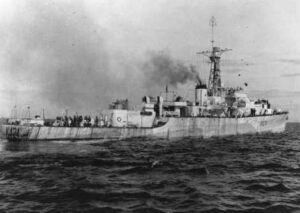 HMS Loch Achanalt was laid down at Henry Robb Limited, Leith on 24 July 1942, launched on 14 September 1942 as the River-class frigate Naver, then completed as a Loch class and launched on 23 September 1943, completed on 11 August 1944. She was transferred to Royal Canadian Navy on completion. She joined the 6th Canadian Escort Group, Londonderry, North-Western Approaches from 7 September 1944. On 16 October she was sent to the South-West of the Faroe Islands to stop U-Boat path from Norway. She had that day a contact, attacked, but not results. This was the badly damaged U-1006. With her radar she picked her up later when surfaced, ran in to attack, the latter firing an T-5 acoustic torpedo which missed. The gun duel was short and deadly, the lost her deck gun, but managed to straddle her with 20-mm gunfore, and was ultimately sank by DCs with 7 going under ou of 52, the rest rescued. In November–December 1944 she received additional bracing to adress her hull stiffness issue, which plagued all the class. In January 1945 she was transferred to the English Channel based at Portsmouth. 14 March-20 April saw them at the South-Western Approaches. She returned to Halifax for convoy defence and on 23 May 1945 her Group was disbanded. Back to Britain, reserve at Sheerness, returned to RN in July and retransferred to the Royal New Zealand Navy on 13 September 1948 as HMNZS Pukaki, discarded in 1965.
HMS Loch Achanalt was laid down at Henry Robb Limited, Leith on 24 July 1942, launched on 14 September 1942 as the River-class frigate Naver, then completed as a Loch class and launched on 23 September 1943, completed on 11 August 1944. She was transferred to Royal Canadian Navy on completion. She joined the 6th Canadian Escort Group, Londonderry, North-Western Approaches from 7 September 1944. On 16 October she was sent to the South-West of the Faroe Islands to stop U-Boat path from Norway. She had that day a contact, attacked, but not results. This was the badly damaged U-1006. With her radar she picked her up later when surfaced, ran in to attack, the latter firing an T-5 acoustic torpedo which missed. The gun duel was short and deadly, the lost her deck gun, but managed to straddle her with 20-mm gunfore, and was ultimately sank by DCs with 7 going under ou of 52, the rest rescued. In November–December 1944 she received additional bracing to adress her hull stiffness issue, which plagued all the class. In January 1945 she was transferred to the English Channel based at Portsmouth. 14 March-20 April saw them at the South-Western Approaches. She returned to Halifax for convoy defence and on 23 May 1945 her Group was disbanded. Back to Britain, reserve at Sheerness, returned to RN in July and retransferred to the Royal New Zealand Navy on 13 September 1948 as HMNZS Pukaki, discarded in 1965.
 HMS Loch Fada (K390)
HMS Loch Fada (K390)
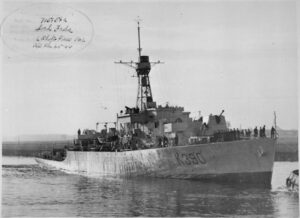 HMS Loch Fada (K390) was ordered to at John Brown & Company, Clydebank on 19 January 1943, laid down 8 June 1943, launched on 14 December 1943 and completed on 14 April 1944. She had an interesting career worth exposing here as the first true lead ship of the class. She staretd with the 2nd Escort Group at Plymouth in June, just after sea trial and took part in the Normandy landings naval phase, Operation Neptune. She co-claimed U-333 on 31 July as well as U-736 and U-385 in early August 1944. She was transferred to Derry for convoy defence, North-West Approaches and from January 1945, to South-Western Approaches. On 27 February she co-claimed U-1018 near Penzance (Cornwall). In May 1945 her Group was transferred to the Home Fleet for the re-occupation of Norway. In July whe was versed to training duties at Derry. In December and in January 1946 she took part in Operation Deadlight, escorted U-boats into the North-Western Approaches to be sunk. She was in the 4th Escort Flotilla from September 1946, 3rd Training Flotilla in early 1949 and by early 1951 she took part in the for HMS Affray. In April 1952 she was in Reserve, selected for modernisation in 1953, recom. on 21 July 1955, Home Fleet and by the fall, Persian Gulf from Bahrain. In March 1956 she was in Mombasa to embark Archbishop Makarios to the Seychelles for detention. Next she was in the East Indies Squadron, stopped at Cochin, Bombay and Karachi and back to the Gulf, then Portsmouth in November and bacl to Bahrain, CENTO exercise, search for the SS Skaubryn, taken in tow. Her back and forth between UK and Bahrain went on and in 1959 reserve, then from January 1960, 6th Frigate Squadron. She was off Iceland on Fishery Protection duties and resumed her Persian Gulf patrol (gun running to rebels in Oman) and CENTO Exercise, ASPEX 7, took part in plane guard duties, then 20th Anniversary of the Siege of Tobruk, modernization at Chatham and service in the Eastern Fleet in 1962–1967.
HMS Loch Fada (K390) was ordered to at John Brown & Company, Clydebank on 19 January 1943, laid down 8 June 1943, launched on 14 December 1943 and completed on 14 April 1944. She had an interesting career worth exposing here as the first true lead ship of the class. She staretd with the 2nd Escort Group at Plymouth in June, just after sea trial and took part in the Normandy landings naval phase, Operation Neptune. She co-claimed U-333 on 31 July as well as U-736 and U-385 in early August 1944. She was transferred to Derry for convoy defence, North-West Approaches and from January 1945, to South-Western Approaches. On 27 February she co-claimed U-1018 near Penzance (Cornwall). In May 1945 her Group was transferred to the Home Fleet for the re-occupation of Norway. In July whe was versed to training duties at Derry. In December and in January 1946 she took part in Operation Deadlight, escorted U-boats into the North-Western Approaches to be sunk. She was in the 4th Escort Flotilla from September 1946, 3rd Training Flotilla in early 1949 and by early 1951 she took part in the for HMS Affray. In April 1952 she was in Reserve, selected for modernisation in 1953, recom. on 21 July 1955, Home Fleet and by the fall, Persian Gulf from Bahrain. In March 1956 she was in Mombasa to embark Archbishop Makarios to the Seychelles for detention. Next she was in the East Indies Squadron, stopped at Cochin, Bombay and Karachi and back to the Gulf, then Portsmouth in November and bacl to Bahrain, CENTO exercise, search for the SS Skaubryn, taken in tow. Her back and forth between UK and Bahrain went on and in 1959 reserve, then from January 1960, 6th Frigate Squadron. She was off Iceland on Fishery Protection duties and resumed her Persian Gulf patrol (gun running to rebels in Oman) and CENTO Exercise, ASPEX 7, took part in plane guard duties, then 20th Anniversary of the Siege of Tobruk, modernization at Chatham and service in the Eastern Fleet in 1962–1967.
She joined the 3rd Frigate Squadron of the Far East Fleet, she was in Colombo in October, in the Indian Ocean, Diego Garcia, Malé, Borneo (Konfrontasi), Pacific (Manus, Admiralty Is., Suva, Phoenix Is., Guam, Hong Kong and Japan and bac tok Borneo.
In 1964 she was in “Exercise JET” with the commando carrier HMS Centaur, then Gulf patrol duties, Singapore posting, Borneo, and several exercises. In September 1965 she was on the 26th Escort Squadron, Singapore, with refits in Hong Kong. In May 1967 after a last visit to Japan she was recalled home, Portsmouth on 11 October 1967, decommissioned, Reserve and later sold for BU.
 HMS Loch Dunvegan (K425)
HMS Loch Dunvegan (K425)
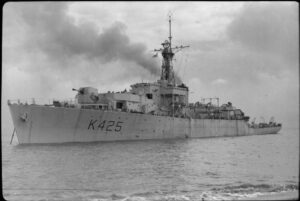 HMS Loch Dunvegan was ordered to Charles Hill & Sons of Bristol in January 1943, laid down 29 September 1943, launched on 25 March 1944 and completed on 30 June 1944.
HMS Loch Dunvegan was ordered to Charles Hill & Sons of Bristol in January 1943, laid down 29 September 1943, launched on 25 March 1944 and completed on 30 June 1944.
She was in the 10th Escort Group, 20th Escort Group (Musrmansk convoys) and JW 59 and on 24 August she co-claimed U-354. She escorted back RA 59A and back to the 10th Escort Group at Derry. On 14 February 1945 she co-claimed U-989 and in March she was transferred to the English Channel. Postwar she was at the 1st AW flotilla, decom. 1947, reactivated in 1950, 2nd frigate flotilla, Mediterranean, Malta (26 June). In May 1951 she was grounded at Mellieħa. While in Port Said in 1952 she quelled anti-British riots. She was in reserve from November 1952 at Devonport and Penarth. She was BU in August 1960 at T. W. Ward (Briton Ferry).
 HMS Loch Eck (K422)
HMS Loch Eck (K422)
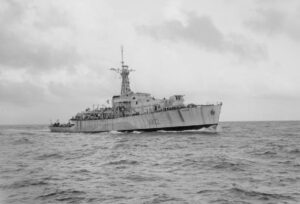 HMS Loch Eck was ordered to Smith’s Dock, South Bank (M’borough) on 25 January 1943 as last of the 1942 program, laid down on 25 October 1943, launched on 25 April 1944, completed on 7 November 1944. 10th Escort Group, Western Approaches (Decemberà then Scapa Flow for the Faeroes–Iceland Gap. On 3 February she sank U-327 off Shetland with her Squid. On 14 February she co-claimed U-989, and on 17 February 1945 U-1278. In March, English Channel, South-Western Approaches, “Force 38”. In April she tested her sonobuoy submarine detection equipment and on 23 May she was in Rosyth Command for “Operation Doomsday” (reoccupation of Norway) and later Operation Deadlight and back to Norway on 6 June with Convoy RN1 taking King Haakon VII back to Oslo.
HMS Loch Eck was ordered to Smith’s Dock, South Bank (M’borough) on 25 January 1943 as last of the 1942 program, laid down on 25 October 1943, launched on 25 April 1944, completed on 7 November 1944. 10th Escort Group, Western Approaches (Decemberà then Scapa Flow for the Faeroes–Iceland Gap. On 3 February she sank U-327 off Shetland with her Squid. On 14 February she co-claimed U-989, and on 17 February 1945 U-1278. In March, English Channel, South-Western Approaches, “Force 38”. In April she tested her sonobuoy submarine detection equipment and on 23 May she was in Rosyth Command for “Operation Doomsday” (reoccupation of Norway) and later Operation Deadlight and back to Norway on 6 June with Convoy RN1 taking King Haakon VII back to Oslo.
After a refit she was assigned to the Indian Ocean in August, East Indies Escort Force to be a Guard ship and for military support duties, repatriations and the Japanese surrender of Bali (February 1946) Lombok (March), and suffered a collision in Colombo, decommissioned at Devonport on 13 August 1946. She was transferred to the RNZN on 1 October 1948 as HMNZS Hawea. Sold September 1965, BU in Hong Kong.
1943 War Programme (26 completed including 2 modified as Coastal Forces Depot Ships):
 HMS Loch Achray (K426)
HMS Loch Achray (K426)
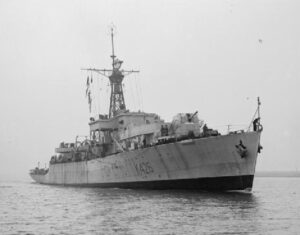 HMS Loch Achray was built by Smith’s Dock, laid down 13 December 1943, launched 7 July 1944 and completed 1 February 1945. 8th Escort Group March 1945, Western Approaches. 12 April sanl U-1024 surfaced by gunfire. Operation Deadlight. From September 1945 East Indies Escort Force. Portsmouth in July 1946, reserve. Transferred to Royal New Zealand Navy on 28 September 1948 as Kaniere.
HMS Loch Achray was built by Smith’s Dock, laid down 13 December 1943, launched 7 July 1944 and completed 1 February 1945. 8th Escort Group March 1945, Western Approaches. 12 April sanl U-1024 surfaced by gunfire. Operation Deadlight. From September 1945 East Indies Escort Force. Portsmouth in July 1946, reserve. Transferred to Royal New Zealand Navy on 28 September 1948 as Kaniere.
 HMS Loch Alvie (K428)
HMS Loch Alvie (K428)
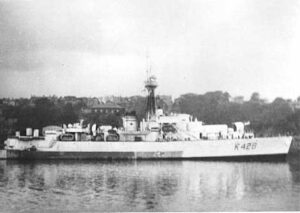 HMS Loch Alvie (K428) – built by Barclay Curle, laid down 31 August 1943, launched 14 April 1944 and completed 21 August 1944. She was transferred to the Royal Canadian Navy on completion, returned to Royal Navy in 1945. Sold 18 January 1965 in Singapore for breaking up.
HMS Loch Alvie (K428) – built by Barclay Curle, laid down 31 August 1943, launched 14 April 1944 and completed 21 August 1944. She was transferred to the Royal Canadian Navy on completion, returned to Royal Navy in 1945. Sold 18 January 1965 in Singapore for breaking up.
 HMS Loch Ard (K602)
HMS Loch Ard (K602)
HMS Loch Ard (K602) was built by Harland & Wolff, laid down 20 January 1944, launched 2 August 1944 and completed 21 May 1945; transferred to South African Navy on completion as SAS Transvaal.
 HMS Loch Arkaig (K603)
HMS Loch Arkaig (K603)
HMS Loch Arkaig (K603) was built by Caledon Shipbuilding, laid down 1 November 1944, launched 7 June 19445 and completed 17 November 1945. Took part in Operation Deadlight (sank U-975, U-3514 with Squid mortar and Shark 4-inch shells). Training duties, Derry. February 1949 escorted HMS Vengeance in the Arctic, Jan Mayen, for Operation Rusty. 1950: Flag Officer Submarines summer war exercises, Haugesund and Nordheimsund (Norway), 6th Frigate Flotilla. April 1951 search for HMS Affray. Decom. 1952 Reserve at Hartlepool. 1957, disposal, 1959 sold to the BISCO for BU in 1960.
 HMS Loch Assynt (K438)
HMS Loch Assynt (K438)
HMS Loch Assynt (K438) – built by Swan Hunter, laid down 11 February 1944, launched 14 December 1944 and completed 2 August 1945 as Coastal Forces depot ship Derby Haven. Sold to Iranian Navy in July 1949 as Babr.
 HMS Loch Boisdale (K432)
HMS Loch Boisdale (K432)
HMS Loch Boisdale (K432) – built by Blyth Dry Dock, laid down 8 November 1943, launched 5 July 1944 and completed 1 December 1944; transferred to South African Navy on completion as SAS Good Hope.
 HMS Loch Craggie (K609)
HMS Loch Craggie (K609)
HMS Loch Craggie (K609) – built by Harland & Wolff, laid down 28 December 1943, launched 23 May 1944 and completed 23 October 1944. Sold 8 July 1963 to break up at Lisbon.
 HMS Loch Cree (K430)
HMS Loch Cree (K430)
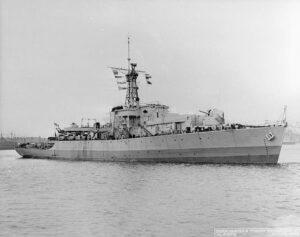 HMS Loch Cree (K430) – built by Swan Hunter, laid down 18 October 1943, launched 19 June 1944 and completed 8 March 1945; transferred to South African Navy on completion as SAS Natal (photo). HMSAS Natal sank U-714 on 14 March 1944. 8th Escort Group of the Western Approaches Command. Refitted for tropical duties, sent to South Africa on 6 June 1945 with HMSAS Good Hope. Decom. 15 March 1972, sunk as target at the cape on 19 September.
HMS Loch Cree (K430) – built by Swan Hunter, laid down 18 October 1943, launched 19 June 1944 and completed 8 March 1945; transferred to South African Navy on completion as SAS Natal (photo). HMSAS Natal sank U-714 on 14 March 1944. 8th Escort Group of the Western Approaches Command. Refitted for tropical duties, sent to South Africa on 6 June 1945 with HMSAS Good Hope. Decom. 15 March 1972, sunk as target at the cape on 19 September.
 HMS Loch Fyne (K429)
HMS Loch Fyne (K429)
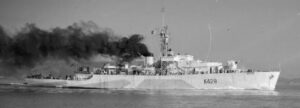 HMS Loch Fyne (K429) – built by Burntisland Shipbuilding, laid down 8 December 1943, launched 24 May 1944 and completed 9 November 1944. 18th Escort Group from 22 December, UK–Gibraltar route. 27 February 1945 “Force 38”, South-Western Approaches. 9 April TG 122.2 Portsmouth, English Channel. May 1945, Scapa Flow, re-occupation of Norway and Operation Deadlight. East Indies Escort Force, Air-Sea Rescue duties, decom. April 1946 Portsmouth. Refitted 1950, 6th Frigate Flotilla. Premature depth charge explosion in sea trials. Searched for HMS Affray. Exercises and visits until March 1952. New refit, recom. 14 February 1956, Persian Gulf, Bahrain in June, southern Gulf, coast of Oman in July, assisted the Swedish tanker MV Julius. January 1957 assisted the Norwegian tanker Gilda, Iranian coast. Guard ship at Shatt al-Arab (Iranian 1958 revolution). Escorted HMS Ceylon at Aqaba, withdrawal from Jordan. Refit, Bahrain July 1959, 9th Frigate Squadron. Bombay 1960 for Exercise Jet, Devonport 8 April. Back 9th FS Bahrain 23 December. April 1961 assisted SS Dara (fire), founded under tow.
HMS Loch Fyne (K429) – built by Burntisland Shipbuilding, laid down 8 December 1943, launched 24 May 1944 and completed 9 November 1944. 18th Escort Group from 22 December, UK–Gibraltar route. 27 February 1945 “Force 38”, South-Western Approaches. 9 April TG 122.2 Portsmouth, English Channel. May 1945, Scapa Flow, re-occupation of Norway and Operation Deadlight. East Indies Escort Force, Air-Sea Rescue duties, decom. April 1946 Portsmouth. Refitted 1950, 6th Frigate Flotilla. Premature depth charge explosion in sea trials. Searched for HMS Affray. Exercises and visits until March 1952. New refit, recom. 14 February 1956, Persian Gulf, Bahrain in June, southern Gulf, coast of Oman in July, assisted the Swedish tanker MV Julius. January 1957 assisted the Norwegian tanker Gilda, Iranian coast. Guard ship at Shatt al-Arab (Iranian 1958 revolution). Escorted HMS Ceylon at Aqaba, withdrawal from Jordan. Refit, Bahrain July 1959, 9th Frigate Squadron. Bombay 1960 for Exercise Jet, Devonport 8 April. Back 9th FS Bahrain 23 December. April 1961 assisted SS Dara (fire), founded under tow.
Joined TF 317 for Operation Vantage (independence from Iraq), refit Karachi. Visited Zanzibar and Mombasa, back home 10 November. Bahrain from 18 June, exercises/port visits, exercises Midlink V. Decom. Devonport 6 May 1963. Sold 7 July 1970 for BU at Newport.
 HMS Loch Glendhu (K619)
HMS Loch Glendhu (K619)
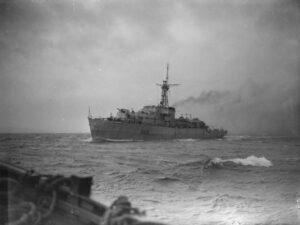 HMS Loch Glendhu was built by Burntisland Shipbuilding, laid down 29 May 1944, launched 18 October 1944 and completed 23 February 1945. She was Broken up in November 1957 at Dunston. No logs.
HMS Loch Glendhu was built by Burntisland Shipbuilding, laid down 29 May 1944, launched 18 October 1944 and completed 23 February 1945. She was Broken up in November 1957 at Dunston. No logs.
 HMS Loch Gorm (K620)
HMS Loch Gorm (K620)
HMS Loch Gorm (K620) – built by Harland & Wolff, laid down 28 December 1943, launched 8 June 1944 and completed 18 December 1944. Reserve, sold in September 1961, becoming mercantile Orion.
 HMS Loch Insh (K433)
HMS Loch Insh (K433)
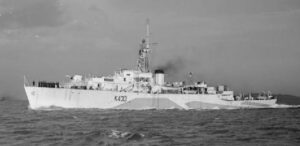 HMS Loch Insh (K433) was laid down at Henry Robb on 17 November 1943, launched 10 May 1944 and completed 20 October 1944. 19th Escort Group, Liverpool November 1944, North-West Approaches, Irish Sea. 6 December with Goodall 14h chase of U-775 off Cape Wrath, escaped. January 1945 English Channel. February Irish Sea, South-Western Approaches. April Russian convoys, JW 66, RA 66. 29 April in the Barents Sea, she sank U-307 with her “Shark” anti-submarine projectiles and Squid. Detached, Leith to refit. 23 August departed for the East Indies Escort Force, Colombo, escort to repatriation convoys. Back hore April 1946, decommissioned, Reserve Devonport. Refit, recom. 21 September 1950, 6th Frigate Flotilla. New refit, recom. 6 September 1954, Mediterranean, Bahrai with Loch Alvie, protecting British tanker shipping & patrols. During Operation Musketeer, protecting Sitra Oil Jetties.January 1957 relieved by Loch Lomond, back to Devonport for refit. TS at Derry. Back to gulf, CENTO Exercise Midlink, East African coast visits. Two more tours of duty 1959-1960 and 1961-1962 in the gulf.
HMS Loch Insh (K433) was laid down at Henry Robb on 17 November 1943, launched 10 May 1944 and completed 20 October 1944. 19th Escort Group, Liverpool November 1944, North-West Approaches, Irish Sea. 6 December with Goodall 14h chase of U-775 off Cape Wrath, escaped. January 1945 English Channel. February Irish Sea, South-Western Approaches. April Russian convoys, JW 66, RA 66. 29 April in the Barents Sea, she sank U-307 with her “Shark” anti-submarine projectiles and Squid. Detached, Leith to refit. 23 August departed for the East Indies Escort Force, Colombo, escort to repatriation convoys. Back hore April 1946, decommissioned, Reserve Devonport. Refit, recom. 21 September 1950, 6th Frigate Flotilla. New refit, recom. 6 September 1954, Mediterranean, Bahrai with Loch Alvie, protecting British tanker shipping & patrols. During Operation Musketeer, protecting Sitra Oil Jetties.January 1957 relieved by Loch Lomond, back to Devonport for refit. TS at Derry. Back to gulf, CENTO Exercise Midlink, East African coast visits. Two more tours of duty 1959-1960 and 1961-1962 in the gulf.
She was transferred to Malaysian Navy 2 October 1964 as Hang Tuah.
 HMS Loch Katrine (K625)
HMS Loch Katrine (K625)
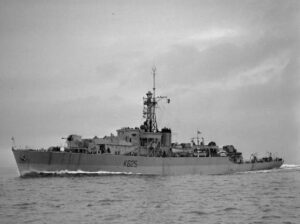 HMS Loch Katrine (K625) – built by Henry Robb, laid down 31 December 1943, launched 21 August 1944 and completed 29 December 1944. After sea trials she joined the 20th Escort Group at Derry on 25 January 1945 and became an escort for a Gibraltar convoy. Back in February she was transferred to 24th Escort Group as Senior Officer’s ship for more Gibraltar convoys, until a German surrender in May. She was deployed in the North-Western Approaches, escorting surrendering U-boats to Lisahally in “Operation Deadlight”. In July she sailed with Loch Quoich to the East Indies Escort Force, Colombo and took paret in the landing in Malaya, Operation Zipper. On 7 September she was at Singapore for the formal surrender ceremonies. She escorted ships until December and dailed to Batavia to support military operations in Dutch East Indies. In 1946 she was in convoy escort in the Malacca Strait and Bay of Bengal (repatriation operations) with Air-Sea Rescues. In March she sailed for Portsmouth to be decom. on 29 April, placed in Reserve. In 1947 she became F625. She was sold to the Royal New Zealand Navy, refitted, recommissioned on 7 May 1949 as Rotoiti on 16 May.
HMS Loch Katrine (K625) – built by Henry Robb, laid down 31 December 1943, launched 21 August 1944 and completed 29 December 1944. After sea trials she joined the 20th Escort Group at Derry on 25 January 1945 and became an escort for a Gibraltar convoy. Back in February she was transferred to 24th Escort Group as Senior Officer’s ship for more Gibraltar convoys, until a German surrender in May. She was deployed in the North-Western Approaches, escorting surrendering U-boats to Lisahally in “Operation Deadlight”. In July she sailed with Loch Quoich to the East Indies Escort Force, Colombo and took paret in the landing in Malaya, Operation Zipper. On 7 September she was at Singapore for the formal surrender ceremonies. She escorted ships until December and dailed to Batavia to support military operations in Dutch East Indies. In 1946 she was in convoy escort in the Malacca Strait and Bay of Bengal (repatriation operations) with Air-Sea Rescues. In March she sailed for Portsmouth to be decom. on 29 April, placed in Reserve. In 1947 she became F625. She was sold to the Royal New Zealand Navy, refitted, recommissioned on 7 May 1949 as Rotoiti on 16 May.
 HMS Loch Killin (K391)
HMS Loch Killin (K391)
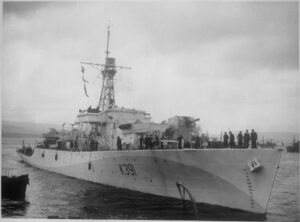 HMS Loch Killin (K391) – built by Burntisland Shipbuilding, laid down 22 June 1943, launched 29 November 1943 and completed 12 April 1944. She co-sank U-333 on 31 July 1944, west of Land’s End. First submarine kill with the Squid. On 6 August 1944 she sank U-736 alone. In January-February 1945 she was detached for service in the English Channel and provided convoy escort/support for short periods. Then the rest of 17 EG was transferred to Plymouth for channel support duty in April. On 15 April 1945 she sank U-1063 in the Channel with gunfire and depth charges. In May 1945 with 17 EG she was based in the Clyde. In June she went to Rosyth Escort Force for convoys to Norway (Stavanger, Bergen, Trondheim). In September she sailed to Dartmouth, decommission, into Reserve on 7 November 1945, BU August 1960 at Newport.
HMS Loch Killin (K391) – built by Burntisland Shipbuilding, laid down 22 June 1943, launched 29 November 1943 and completed 12 April 1944. She co-sank U-333 on 31 July 1944, west of Land’s End. First submarine kill with the Squid. On 6 August 1944 she sank U-736 alone. In January-February 1945 she was detached for service in the English Channel and provided convoy escort/support for short periods. Then the rest of 17 EG was transferred to Plymouth for channel support duty in April. On 15 April 1945 she sank U-1063 in the Channel with gunfire and depth charges. In May 1945 with 17 EG she was based in the Clyde. In June she went to Rosyth Escort Force for convoys to Norway (Stavanger, Bergen, Trondheim). In September she sailed to Dartmouth, decommission, into Reserve on 7 November 1945, BU August 1960 at Newport.
 HMS Loch Killisport (K628)
HMS Loch Killisport (K628)
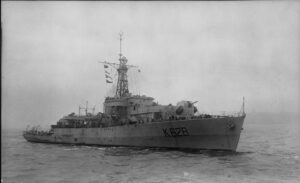 HMS Loch Killisport (K628) – built by Harland & Wolff, laid down 28 December 1943, launched 6 July 1944 and completed 9 July 1945. After sea trials she was sent to the Far East (Eastern Fleet) in August and by September sailed from Aden to Cochin and Colombo in October 1945. Based at Singapore for operations in Java and Sumatra, escort of POW repatriations and civilian internees with Prince Philip as an officer on board. Back in UK by April 1946 she was decommissioned in Reserve at Plymouth. In 1948 she became F628. She had a first time in the Home Fleet, 1950–1952 after refit with the 6th Frigate Flotilla, ASW TS at Derry, search for HMS Affray, Mediterranean Sea tour, decom. April 1952, Reserve at Chatham until April 1953, modernized at Blackwall Yard and tropicalized at Chatham. Next she served in the Gulf and Far East, 1955–1965, assisted ships in the Strait of Hormuz, was based in Bahrain, was in Trincomalee for CENTO “Exercise Jet 55”, relieved by Loch Fada in January 1956 and refitted at Portsmouth, then bact in the Persian Gulf in October 1956, via the Cape of Good Hope (closure of the Suez Canal). She had exercises with the IN in Cochin in April and the Iranian Navy in June. After a refit back fome she was back in the Persian Gulf from February 1958, relieving Loch Fada at Muscat in Oman and back in Portsmouth in February 1959 for a refit. Back to the Gulf in September, CENTO “Exercise Jet 59” at Cochin, “Exercise Winged Khanga” with HMS Centaur in March 1960, squadron exercises CASPEX 5 in May. Refit at Rosyth. From September 1961: 3rd Frigate Squadron in Far East Fleet, Singapore. Patrolled during the Indonesia–Malaysia confrontation from Tawau. “Exercise Jet 62” and Japan exercises with the USN. Borneo patorls from Labuan. Sydney, “Exercise Tucker Box”. January 1963 Sandakan, Borneo, refit at Singapore, Borneo and Fleet exercises. Exercises with the Royal Thai Navy in April 1965. Portsmouth decommission, on 4 August 1965, Reserve, Disposal List, sold to BISCO 20 February 1970 for BU.
HMS Loch Killisport (K628) – built by Harland & Wolff, laid down 28 December 1943, launched 6 July 1944 and completed 9 July 1945. After sea trials she was sent to the Far East (Eastern Fleet) in August and by September sailed from Aden to Cochin and Colombo in October 1945. Based at Singapore for operations in Java and Sumatra, escort of POW repatriations and civilian internees with Prince Philip as an officer on board. Back in UK by April 1946 she was decommissioned in Reserve at Plymouth. In 1948 she became F628. She had a first time in the Home Fleet, 1950–1952 after refit with the 6th Frigate Flotilla, ASW TS at Derry, search for HMS Affray, Mediterranean Sea tour, decom. April 1952, Reserve at Chatham until April 1953, modernized at Blackwall Yard and tropicalized at Chatham. Next she served in the Gulf and Far East, 1955–1965, assisted ships in the Strait of Hormuz, was based in Bahrain, was in Trincomalee for CENTO “Exercise Jet 55”, relieved by Loch Fada in January 1956 and refitted at Portsmouth, then bact in the Persian Gulf in October 1956, via the Cape of Good Hope (closure of the Suez Canal). She had exercises with the IN in Cochin in April and the Iranian Navy in June. After a refit back fome she was back in the Persian Gulf from February 1958, relieving Loch Fada at Muscat in Oman and back in Portsmouth in February 1959 for a refit. Back to the Gulf in September, CENTO “Exercise Jet 59” at Cochin, “Exercise Winged Khanga” with HMS Centaur in March 1960, squadron exercises CASPEX 5 in May. Refit at Rosyth. From September 1961: 3rd Frigate Squadron in Far East Fleet, Singapore. Patrolled during the Indonesia–Malaysia confrontation from Tawau. “Exercise Jet 62” and Japan exercises with the USN. Borneo patorls from Labuan. Sydney, “Exercise Tucker Box”. January 1963 Sandakan, Borneo, refit at Singapore, Borneo and Fleet exercises. Exercises with the Royal Thai Navy in April 1965. Portsmouth decommission, on 4 August 1965, Reserve, Disposal List, sold to BISCO 20 February 1970 for BU.
 HMS Loch Lomond (K437)
HMS Loch Lomond (K437)
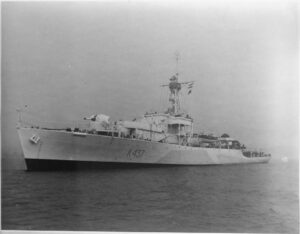 HMS Loch Lomond (K437) – built by Caledon Shipbuilding, laid down 7 December 1943, launched 19 June 1944 and completed 16 November 1944. Joined the 17th Escort Group from 11 December and was based in Scotland until May 1945 with sweeps in the English Channel escorting convoys. East Indies after modifications, Ceylon. Took part in Operation Zipper in Malaya (cancelled, surrender of Japan). Singapore, local operations. Back home April 1946, decommissioned, reserve 1948 as Recommissioned 22 September 1950, Mediterranean Fleet (Malta) and Red Sea patrol, decommissioned 21 October 1952, overhaul mod. 1953-1955, recom. 19 April 1955, Mediterranean Fleet, Persian Gulf and India Patrol. Refit UK April 1956. Gulf-Indian Ocean duries, refit back home 1958-1959, recommissioned in September, Persian Gulf from February 1960. Refit home 26 January 1961, 9th Frigate Squadron, Gulf, Singapore 3rd Frigate Squadron (Far East Fleet) from 18 October 1962. By March 1963 Indonesia–Malaysia confrontation, Guard ship Maldives. Carried the rebel leader to the Seychelles. Exercises Indian Ocean-South China Sea, decom. in UK 19 December 1964, disposal List February 1965, Portsmouth until 1967, sold 6 September 1968, BU at Faslane.
HMS Loch Lomond (K437) – built by Caledon Shipbuilding, laid down 7 December 1943, launched 19 June 1944 and completed 16 November 1944. Joined the 17th Escort Group from 11 December and was based in Scotland until May 1945 with sweeps in the English Channel escorting convoys. East Indies after modifications, Ceylon. Took part in Operation Zipper in Malaya (cancelled, surrender of Japan). Singapore, local operations. Back home April 1946, decommissioned, reserve 1948 as Recommissioned 22 September 1950, Mediterranean Fleet (Malta) and Red Sea patrol, decommissioned 21 October 1952, overhaul mod. 1953-1955, recom. 19 April 1955, Mediterranean Fleet, Persian Gulf and India Patrol. Refit UK April 1956. Gulf-Indian Ocean duries, refit back home 1958-1959, recommissioned in September, Persian Gulf from February 1960. Refit home 26 January 1961, 9th Frigate Squadron, Gulf, Singapore 3rd Frigate Squadron (Far East Fleet) from 18 October 1962. By March 1963 Indonesia–Malaysia confrontation, Guard ship Maldives. Carried the rebel leader to the Seychelles. Exercises Indian Ocean-South China Sea, decom. in UK 19 December 1964, disposal List February 1965, Portsmouth until 1967, sold 6 September 1968, BU at Faslane.
 HMS Loch More (K639)
HMS Loch More (K639)
HMS Loch More (K639) – built by Caledon Shipbuilding, laid down 16 March 1944, launched 3 October 1944 and completed 24 February 1945. Group at Greenock, convoy defence in NW Approaches and Irish Sea. Attacked U1024 in March. Based in Milford Haven. Operation DEADLIGHT. Refit, Med service. Operation ZIPPER. Saw service in the Indian Ocean in 1946. See the full logs in the sources below. Broken up in August 1963 at Inverkeithing.
 HMS Loch Morlich (K517)
HMS Loch Morlich (K517)
 HMS Loch Morlich (K517) – built by Swan Hunter, laid down 15 July 1943, launched 25 January 1944 and completed 2 August 1944; transferred to Royal Canadian Navy on completion. Training at Tobermory, convoy escort group EG 6, Derry until April 1945. Sent to Halifax, remained until May, Returned to Royal Navy, decommissioned 20 June 1945 at Sheerness, reserve in Sheerness sold to NZ 1948. Transferred to Royal New Zealand Navy on 11 April 1949 as Tutira. Naval blockade, Korean War, Battle of Inchon, screening force. In reserve in September 1951 until sold for scrap, 1961, BU 1966 at Hong Kong.
HMS Loch Morlich (K517) – built by Swan Hunter, laid down 15 July 1943, launched 25 January 1944 and completed 2 August 1944; transferred to Royal Canadian Navy on completion. Training at Tobermory, convoy escort group EG 6, Derry until April 1945. Sent to Halifax, remained until May, Returned to Royal Navy, decommissioned 20 June 1945 at Sheerness, reserve in Sheerness sold to NZ 1948. Transferred to Royal New Zealand Navy on 11 April 1949 as Tutira. Naval blockade, Korean War, Battle of Inchon, screening force. In reserve in September 1951 until sold for scrap, 1961, BU 1966 at Hong Kong.
 HMS Loch Quoich (K434)
HMS Loch Quoich (K434)
HMS Loch Quoich (K434) – built by Blyth Dry Dock, laid down 3 December 1943, launched 2 September 1944 and completed 11 January 1945. Broken up in November 1957 at Dunston.
 HMS Loch Ruthven (K645)
HMS Loch Ruthven (K645)
HMS Loch Ruthven (K645) – built by Charles Hill & Sons, laid down 4 January 1944, launched 3 June 1944 and completed 6 October 1944. Broken up in 1966 at Plymouth.
 HMS Loch Scavaig (K648)
HMS Loch Scavaig (K648)
HMS Loch Scavaig (K648) – built by Charles Hill & Sons, laid down 31 March 1944, launched 9 September 1944 and completed 22 December 1944. Broken up in September 1959 at Genoa.
 HMS Loch Shin (K421)
HMS Loch Shin (K421)
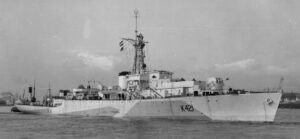 HMS Loch Shin (K421) – built by Swan Hunter, laid down 6 September 1943, launched 23 February 1944 and completed 10 October 1944. Western Approaches. 4 February 1945 attacked U-1014, sunk. Russian convoys. 1946 Operation Deadlight. PO June 1947, reserve. Transferred to Royal New Zealand Navy on 13 September 1948 as Taupo (F421). Pacific and Mediterranean service and 1951-1952 Korean War, escort and shore bombardment operations in Inchon. PO late 1952, reserve at Auckland, sold for scrap December 1961.
HMS Loch Shin (K421) – built by Swan Hunter, laid down 6 September 1943, launched 23 February 1944 and completed 10 October 1944. Western Approaches. 4 February 1945 attacked U-1014, sunk. Russian convoys. 1946 Operation Deadlight. PO June 1947, reserve. Transferred to Royal New Zealand Navy on 13 September 1948 as Taupo (F421). Pacific and Mediterranean service and 1951-1952 Korean War, escort and shore bombardment operations in Inchon. PO late 1952, reserve at Auckland, sold for scrap December 1961.
 HMS Loch Tarbert (K431)
HMS Loch Tarbert (K431)
HMS Loch Tarbert (K431) – built by Ailsa Shipbuilding, laid down 30 November 1943, launched 19 October 1944 and completed 22 February 1945. Broken up in September 1959 at Genoa.
 HMS Loch Torridon (K654)
HMS Loch Torridon (K654)
HMS Loch Torridon (K654) – built by Swan Hunter, launched 13 January 1945 and completed 19 October 1945 as Coastal Forces depot ship HMS Woodbridge Haven. Broken up August 1965 at Blyth.
 HMS Loch Tralaig (K655)
HMS Loch Tralaig (K655)
HMS Loch Tralaig (K655) – built by Caledon Shipbuilding, laid down 26 June 1944, launched 12 February 1945 and completed 4 July 1945. Broken up in August 1963 at Bo’ness.
 HMS Loch Veyatie (K658)
HMS Loch Veyatie (K658)
HMS Loch Veyatie (K658) – built by Ailsa Shipbuilding, laid down 30 March 1944, launched 8 October 1945 and completed 13 July 1946. Broken up in August 1965 at Dalmuir.
Sources
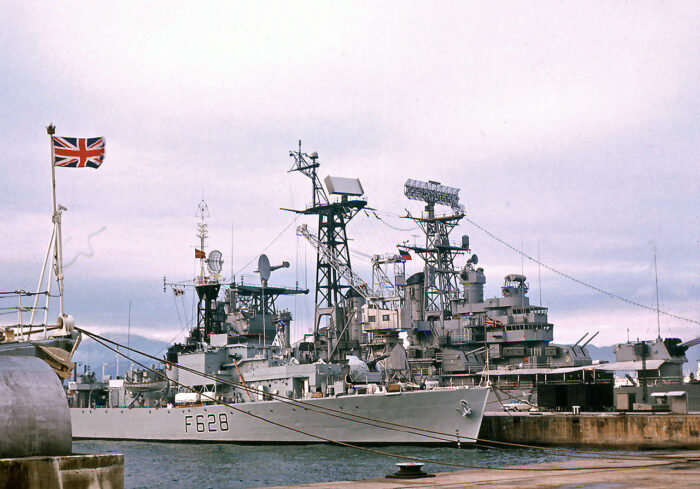
HMS Loch Killisport (F628), Hong-Kong 1964
Books
Loch Class Frigates, Patrick Boniface, Maritime Books, 2013
Colledge, J. J.; Warlow, Ben (2006) [1969]. Ships of the Royal Navy: The Complete Record of all Fighting Ships of the Royal Navy (Rev. ed.). Chatham Publishing.
British and Empire Warships of the Second World War, H T Lenton, Greenhill Books
Royal Navy Frigates 1945–1983, Leo Marriott, Ian Allan, 1983
Uboat.net article on Loch class frigates
Links
https://web.archive.org/web/20220307200528/http://www.lochclassfrigates.com/
https://www.navypedia.org/ships/uk/brit_fr_loch.htm
https://web.archive.org/web/20090307052113/http://www.operationdeadlight.co.uk/history.htm
https://uboat.net/allies/warships/class.html?ID=6
https://www.shipbucket.com/forums/viewtopic.php?t=9560
https://ww2talk.com/index.php?threads/the-shark-anti-submarine-projectile.55368/
https://en.wikipedia.org/wiki/Loch-class_frigate
http://www.naval-history.net/xGM-Chrono-15Fr-Loch-LochArkaig.htm
https://commons.wikimedia.org/wiki/Category:Loch_class_frigates
http://www.naval-history.net/xGM-Chrono-15Fr-Loch-LochKillisport.htm
http://www.naval-history.net/xGM-Chrono-15Fr-Loch-LochMore.htm
http://www.naval-history.net/xGM-Ops-SalvageOps1950-64.htm
navybooks.com loch class frigates by Patrick Boniface
British Sloops and Frigates of the Second World War – Les Brown
Model Kits
Loch class Frigate: HMS Loch Katrine, Deans Marine 1:96
https://www.scalemates.com/search.php?fkSECTION%5B%5D=All&q=loch+class+frigates*
1/96 plans, rmg.co.uk

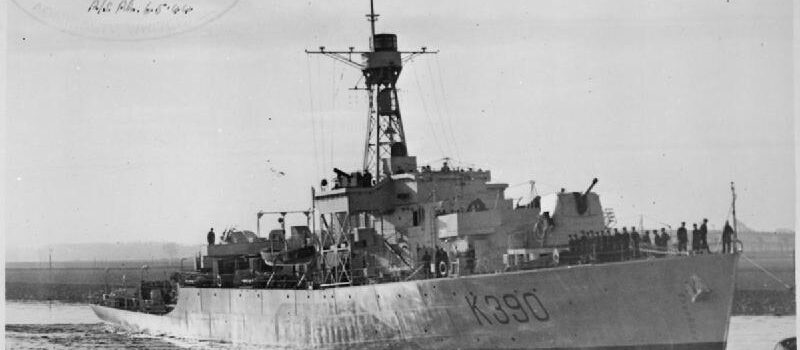

 South African Navy
South African Navy Royal Malaysian Navy
Royal Malaysian Navy Latest Facebook Entry -
Latest Facebook Entry -  X(Tweeter) Naval Encyclopedia's deck archive
X(Tweeter) Naval Encyclopedia's deck archive Instagram (@navalencyc)
Instagram (@navalencyc)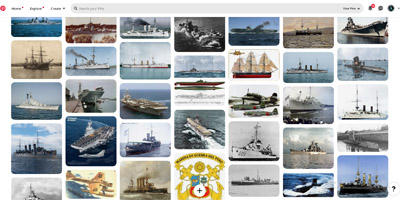

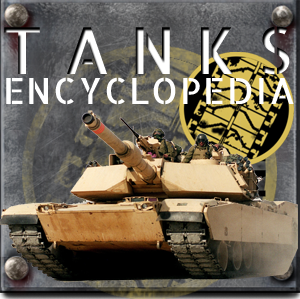
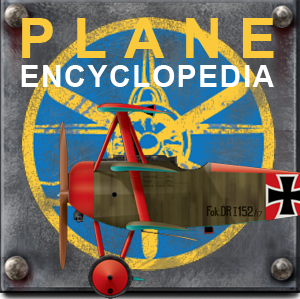
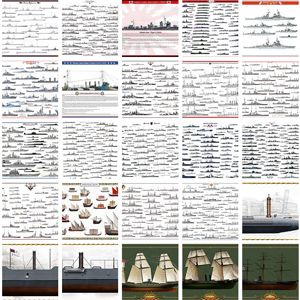
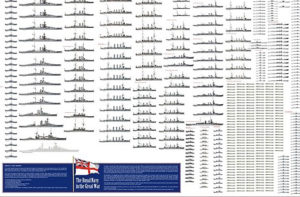
 French Navy
French Navy Royal Navy
Royal Navy Russian Navy
Russian Navy Armada Espanola
Armada Espanola Austrian Navy
Austrian Navy K.u.K. Kriegsmarine
K.u.K. Kriegsmarine Dansk Marine
Dansk Marine Nautiko Hellenon
Nautiko Hellenon Koninklije Marine 1870
Koninklije Marine 1870 Marinha do Brasil
Marinha do Brasil Osmanlı Donanması
Osmanlı Donanması Marina Do Peru
Marina Do Peru Marinha do Portugal
Marinha do Portugal Regia Marina 1870
Regia Marina 1870 Nihhon Kaigun 1870
Nihhon Kaigun 1870 Preußische Marine 1870
Preußische Marine 1870 Russkiy Flot 1870
Russkiy Flot 1870 Svenska marinen
Svenska marinen Søværnet
Søværnet Union Navy
Union Navy Confederate Navy
Confederate Navy Armada de Argentina
Armada de Argentina Imperial Chinese Navy
Imperial Chinese Navy Marinha do Portugal
Marinha do Portugal Mexico
Mexico Kaiserliche Marine
Kaiserliche Marine 1898 US Navy
1898 US Navy Sovietskiy Flot
Sovietskiy Flot Royal Canadian Navy
Royal Canadian Navy Royal Australian Navy
Royal Australian Navy RNZN Fleet
RNZN Fleet Chinese Navy 1937
Chinese Navy 1937 Kriegsmarine
Kriegsmarine Chilean Navy
Chilean Navy Danish Navy
Danish Navy Finnish Navy
Finnish Navy Hellenic Navy
Hellenic Navy Polish Navy
Polish Navy Romanian Navy
Romanian Navy Turkish Navy
Turkish Navy Royal Yugoslav Navy
Royal Yugoslav Navy Royal Thai Navy
Royal Thai Navy Minor Navies
Minor Navies Albania
Albania Austria
Austria Belgium
Belgium Columbia
Columbia Costa Rica
Costa Rica Cuba
Cuba Czechoslovakia
Czechoslovakia Dominican Republic
Dominican Republic Haiti
Haiti Hungary
Hungary Honduras
Honduras Estonia
Estonia Iceland
Iceland Eire
Eire Equador
Equador Iran
Iran Iraq
Iraq Latvia
Latvia Liberia
Liberia Lithuania
Lithuania Mandchukuo
Mandchukuo Morocco
Morocco Nicaragua
Nicaragua Persia
Persia San Salvador
San Salvador Sarawak
Sarawak Uruguay
Uruguay Venezuela
Venezuela Zanzibar
Zanzibar Warsaw Pact Navies
Warsaw Pact Navies Bulgaria
Bulgaria Hungary
Hungary

 Bundesmarine
Bundesmarine Dutch Navy
Dutch Navy Hellenic Navy
Hellenic Navy Marina Militare
Marina Militare Yugoslav Navy
Yugoslav Navy Chinese Navy
Chinese Navy Indian Navy
Indian Navy Indonesian Navy
Indonesian Navy JMSDF
JMSDF North Korean Navy
North Korean Navy Pakistani Navy
Pakistani Navy Philippines Navy
Philippines Navy ROKN
ROKN Rep. of Singapore Navy
Rep. of Singapore Navy Taiwanese Navy
Taiwanese Navy IDF Navy
IDF Navy Saudi Navy
Saudi Navy Royal New Zealand Navy
Royal New Zealand Navy Egyptian Navy
Egyptian Navy South African Navy
South African Navy






























 Ukrainian Navy
Ukrainian Navy dbodesign
dbodesign